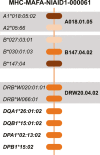Characterization of 100 extended major histocompatibility complex haplotypes in Indonesian cynomolgus macaques
- PMID: 32112172
- PMCID: PMC7223175
- DOI: 10.1007/s00251-020-01159-5
Characterization of 100 extended major histocompatibility complex haplotypes in Indonesian cynomolgus macaques
Abstract
Many medical advancements-including improvements to anti-rejection therapies in transplantation and vaccine development-rely on preclinical studies conducted in cynomolgus macaques (Macaca fascicularis). Major histocompatibility complex (MHC) class I and class II genes of cynomolgus macaques are orthologous to human leukocyte antigen complex (HLA) class I and class II genes, respectively. Both encode cell-surface proteins involved in cell recognition and rejection of non-host tissues. MHC class I and class II genes are highly polymorphic, so comprehensive genotyping requires the development of complete databases of allelic variants. Our group used PacBio circular consensus sequencing of full-length cDNA amplicons to characterize MHC class I and class II transcript sequences for a cohort of 293 Indonesian cynomolgus macaques (ICM) in a large, pedigreed breeding colony. These studies allowed us to expand the existing database of Macaca fascicularis (Mafa) alleles by identifying an additional 141 MHC class I and 61 class II transcript sequences. In addition, we defined co-segregating combinations of allelic variants as regional haplotypes for 70 Mafa-A, 78 Mafa-B, and 45 Mafa-DRB gene clusters. Finally, we defined class I and class II transcripts that are associated with 100 extended MHC haplotypes in this breeding colony by combining our genotyping analyses with short tandem repeat (STR) patterns across the MHC region. Our sequencing analyses and haplotype definitions improve the utility of these ICM for transplantation studies as well as infectious disease and vaccine research.
Keywords: Haplotype; Macaca fascicularis; Major histocompatibility complex; Short tandem repeat; Transplantation.
Conflict of interest statement
The authors declare that they have no conflicts of interest.
Figures




Similar articles
-
Dynamic evolution of Mhc haplotypes in cynomolgus macaques of different geographic origins.Immunogenetics. 2022 Aug;74(4):409-429. doi: 10.1007/s00251-021-01249-y. Epub 2022 Jan 27. Immunogenetics. 2022. PMID: 35084546 Free PMC article.
-
Major histocompatibility complex haplotyping and long-amplicon allele discovery in cynomolgus macaques from Chinese breeding facilities.Immunogenetics. 2017 Apr;69(4):211-229. doi: 10.1007/s00251-017-0969-7. Epub 2017 Jan 11. Immunogenetics. 2017. PMID: 28078358 Free PMC article.
-
Multilocus definition of MHC haplotypes in pedigreed cynomolgus macaques (Macaca fascicularis).Immunogenetics. 2012 Oct;64(10):755-65. doi: 10.1007/s00251-012-0632-2. Epub 2012 Jul 8. Immunogenetics. 2012. PMID: 22772814 Free PMC article.
-
Haplessly hoping: macaque major histocompatibility complex made easy.ILAR J. 2013;54(2):196-210. doi: 10.1093/ilar/ilt036. ILAR J. 2013. PMID: 24174442 Free PMC article. Review.
-
The Cynomolgus Macaque MHC Polymorphism in Experimental Medicine.Cells. 2019 Aug 26;8(9):978. doi: 10.3390/cells8090978. Cells. 2019. PMID: 31455025 Free PMC article. Review.
Cited by
-
Long-read assembly of major histocompatibility complex and killer cell immunoglobulin-like receptor genome regions in cynomolgus macaque.Biol Direct. 2022 Nov 29;17(1):36. doi: 10.1186/s13062-022-00350-w. Biol Direct. 2022. PMID: 36447238 Free PMC article.
-
The anti-CD40L monoclonal antibody AT-1501 promotes islet and kidney allograft survival and function in nonhuman primates.Sci Transl Med. 2023 Aug 30;15(711):eadf6376. doi: 10.1126/scitranslmed.adf6376. Epub 2023 Aug 30. Sci Transl Med. 2023. PMID: 37647390 Free PMC article.
-
Dynamic evolution of Mhc haplotypes in cynomolgus macaques of different geographic origins.Immunogenetics. 2022 Aug;74(4):409-429. doi: 10.1007/s00251-021-01249-y. Epub 2022 Jan 27. Immunogenetics. 2022. PMID: 35084546 Free PMC article.
-
The Impact and Effects of Host Immunogenetics on Infectious Disease Studies Using Non-Human Primates in Biomedical Research.Microorganisms. 2024 Jan 12;12(1):155. doi: 10.3390/microorganisms12010155. Microorganisms. 2024. PMID: 38257982 Free PMC article. Review.
-
Major histocompatibility complex class II DR and DQ evolution and variation in wild capuchin monkey species (Cebinae).PLoS One. 2021 Aug 12;16(8):e0254604. doi: 10.1371/journal.pone.0254604. eCollection 2021. PLoS One. 2021. PMID: 34383779 Free PMC article.
References
-
- Aarnink A, Mee ET, Savy N, Congy-Jolivet N, Rose NJ, Blancher A. Deleterious impact of feto-maternal MHC compatibility on the success of pregnancy in a macaque model. Immunogenetics. 2014;66(2):105–113. - PubMed
-
- Bruijnesteijn J, van der Wiel MKH, Swelsen WTN, Otting N, de Vos-Rouweler AJM, Elferink D, Doxiadis GG, Claas FHJ, Lardy NM, de Groot NG, Bontrop RE. Human and rhesus macaque KIR haplotypes defined by their transcriptomes. J Immunol. 2018;200(5):1692–1701. - PubMed
Publication types
MeSH terms
Grants and funding
- P51OD011106/National Institutes of Health Office of Research Infrastructure Programs/International
- RR020141-01/Foundation for the National Institutes of Health/International
- RR15459-01/Foundation for the National Institutes of Health/International
- T32 GM008692/GM/NIGMS NIH HHS/United States
- T15 LM007359/LM/NLM NIH HHS/United States
LinkOut - more resources
Full Text Sources
Research Materials

